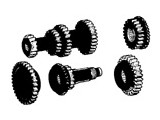Synchromesh Transmissions
Most modern cars are fitted with a full synchronized engagement gearbox. This relatively old design concept assure the delivery of smooth, reliable, and quiet operation. This is an absolute must have for any car that is a daily driven vehicle. Synchromesh transmissions operate using a special collar that applies force to a cone-shaped area attached to the gear. The collar allows the shaft speed of the gearset and the input shaft to be matched or “synched” to the output shaft prior to the collar locking into place and initiating a shift.
As even a street racer is driven at relatively slow engine speeds (Below 6,000prm) Synchromesh gear engagement is ideal and requires a bit more time compared to a dog box, to facilitate shifts. Limitations of synchromesh gearboxes in high-performance applications include slow upshifting at very high engine speeds—e.g. 8,000 rpm—and slow downshifting, as well as the need to fully use the clutch.
Dog Box Transmissions
Dog engagement is typically limited to racing applications where fast, precise shifting is needed. Dog gear engagement works by having numerous large teeth or ‘dogs’ that mate into matching openings machined into the opposite surface of the drive gear. Unlike the synchro engagement, there is no synchronizing mechanism to assist in equalizing speed. Ideal gear selection—e.g. minimal clashing and wear of the dog rings—is achieved by quick shifts; the motto here is “the quicker the better”, so bang away.
Unlike a conventional synchro gearbox that a clutch MUST be used, it is far better in a dog box to lift your foot off the gas momentarily to give a little break in engine load until the shift is achieved. The driver will then experience the dog ring engaging with the next gear and the throttle can be reapplied. With practice this can be done in milliseconds. In fact, a driver can preload the stick shift in the direction of the next shift, and then when he either blips the throttle or clutch the shifter will quickly click in the desired gear.
With all else equal, dog-engagement gears are much stronger than synchro-engagement gears because without needing to make space for synchro rings, the gears themselves can be made thicker. The number of dogs (teeth) and the size of the openings determine the window of opportunity that the dogs have to engage during the shift event. Rings with a smaller number of teeth provide a more efficient, smoother shift quality. The downsides to this easier engagement are increased noise and abruptness on the shift.
The most destructive method of shifting dog gears is attempting to change gears in a “passenger car” or “synchromesh” manner. This involves slow shifting and use of the clutch—i.e. lifting off the throttle, depressing the clutch, moving the gear lever slowly, releasing the clutch, and applying the throttle—a scenario typically found in stop-and-go traffic.








